Abstract
Curcuma subgenus Hitcheniopsis (Zingiberaceae) comprises species valued for ornamental and medicinal uses in Southeast Asia, yet no comprehensive assessment has been conducted in Vietnam. This study provides the first integrative evaluation of Hitcheniopsis in Vietnam, combining species distribution modeling, field verification, herbarium examination, and Ornamental Value Index (OVI) analysis. Ten species were confirmed, including a new national record, C. rhabdota, with voucher specimens establishing its verified presence and extending the known range. Predicted habitat maps highlighted southern Vietnam and adjacent regions as suitable areas, guiding targeted surveys and conservation planning. Flowering occurred from April to September, with species occupying habitats from deciduous dipterocarp to dry evergreen forests. OVI analysis identified C. rhabdota, C. alismatifolia, and C. thorelii as species of high ornamental potential, supporting their use in horticultural breeding and potted ornamental production. Conservation assessments revealed that the endemic C. leonidii and C. pygmaea are Critically Endangered, C. rhabdota is Vulnerable, and C. sparganiifolia is Endangered, emphasizing the urgency of habitat protection and sustainable management. By linking verified diversity, phenology, ornamental value, and habitat modeling, this study establishes a novel, distribution-based framework for research, conservation, and sustainable use of Curcuma subgenus Hitcheniopsis in Vietnam and Southeast Asia.
Keywords:
Curcuma; diversity; Hitcheniopsis; new record; ornamental value; taxonomy; traditional uses; Vietnam; Zingibereae 1. Introduction
Curcuma L., a genus of tropical rhizomatous plants in the family Zingiberaceae, is widely valued in Southeast Asia [1,2,3,4,5,6] for its ornamental, medicinal, and cultural uses [7,8,9,10,11,12,13]. Among its subgenera, Hitcheniopsis is particularly notable for its vibrant and diverse inflorescences, making it highly attractive as an ornamental plant and as parental material for cultivated varieties [14,15,16,17,18,19]. Members of this subgenus are traditionally used by local communities in cultural or ritual practices and as auspicious ornamental plants [6,7,8,9,10,12].
Vietnam represents a biogeographically significant area within the Indochinese floristic region, forming a transitional zone between the tropical flora of Southeast Asia and the subtropical flora of southern China. The country harbors exceptionally high species richness and endemism, particularly within the Zingiberaceae, due to its varied topography and climatic gradients [20,21,22,23,24,25,26]. Moreover, Vietnam marks the eastern distribution limit of Curcuma subgenus Hitcheniopsis, as no species of this subgenus have been recorded from the forests of the Philippines or Indonesia [3,4,6]. This highlights Vietnam’s pivotal role in understanding the biogeography and evolutionary history of the group across continental Southeast Asia.
Despite their aesthetic and cultural significance, knowledge of the diversity, flowering phenology, ornamental potential, and conservation status of Curcuma subgenus Hitcheniopsis in Vietnam remains incomplete. Although certain species are mentioned and illustrated in these works, no voucher specimens or collection references are clearly provided. In some cases, species are misidentified, and several taxa have not yet been included in these references [3,4]. Some species display considerable ornamental value due to their showy bracts or leaves, extended flowering periods, and adaptability to cultivation, yet their horticultural use remains underexplored. Additionally, habitat loss and overharvesting threaten some species, emphasizing the need for systematic conservation assessment to guide sustainable utilization [27,28].
This study aims to (1) document the diversity of Curcuma subgenus Hitcheniopsis in Vietnam, including the first verified record of C. rhabdota in Tây Ninh Province; (2) record traditional uses among local communities; (3) evaluate ornamental potential using the Ornamental Value Index; and (4) assess conservation status. By integrating ethnobotanical, horticultural, and conservation data, this work provides a foundation for sustainable cultivation, conservation planning, and the continued use of these valuable species in Vietnam and the broader Southeast Asian region.
2. Materials and Methods
2.1. Plant Material and Study Area
Specimens of Curcuma subgenus Hitcheniopsis were collected from Vietnam (Figure 1) from late February to September, during their flowering stage. Some species produce inflorescences before the leafy shoots between late February and May, while others produce terminal inflorescences from June to September. Collecting specimens during the flowering stage ensures that key morphological characteristics, particularly those of the inflorescence and flowers, are accurately observed for correct species identification. Voucher specimens were preserved as dried herbarium samples and deposited at the Vascular Plant Herbarium, Mahasarakham University (VMSU).
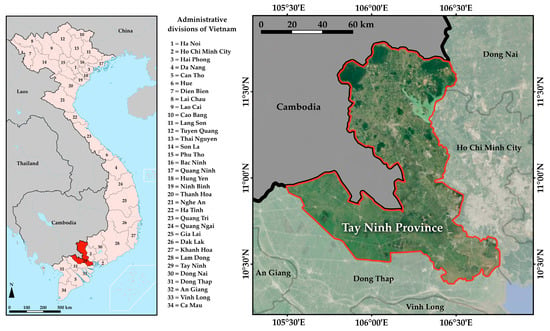
Figure 1.
Map of Vietnam showing administrative division boundaries, with Tay Ninh Province highlighted in red, adapted from ref. [29], licensed under CC BY 4.0 (left). Topographic map of the Tay Ninh Province study area (right).
2.2. Taxonomic Identification
Species identification was performed using dichotomous keys and relevant literature, including the Flora of Vietnam Vol. 21 [4], Flora of China Vol. 24 [5], Flora of Thailand Vol.16 Part 2 [6], and other publications on Curcuma taxonomy [1,2,7,9,10,11,12,13,16,30,31,32,33,34,35,36,37]. Morphological traits of vegetative and reproductive structures were measured with a ruler and vernier caliper (Mitutoyo Vernier Caliper; Mitutoyo Corporation, Kawasaki, Japan) and observed in detail using a stereoscopic microscope (Stemi 2000-C; Zeiss, Oberkochen, Germany). High-resolution images of type specimens were consulted through major herbaria, e.g., BK, BKF, E, HN, HNU, IBK, IMDY, K, KKU, P, QBG, VMSU, VNM, and VNMN, including via JSTOR Global Plants (https://plants.jstor.org, accessed on 17 August 2025) and the Global Biodiversity Information Facility (GBIF) [38].
2.3. Information on Traditional Uses
Information on the traditional uses of Curcuma subgenus Hitcheniopsis was compiled from published literature, botanical references, and herbarium specimen notes. These records were used to observe and summarize the various uses of each species beyond ornamental purposes, e.g., culinary, medicinal, or other applications [39,40]. No comprehensive ethnobotanical survey or quantitative analysis was conducted, and semi-structured interviews with local informants were only consulted as Supplementary Information where available. This approach allows the study to note general traditional uses while keeping the focus on ornamental value, diversity, and conservation assessments [8,9].
2.4. Preliminary Evaluation of Ornamental Value for Cultivation as Ornamental Pot Plants
Specimens of Curcuma subgenus Hitcheniopsis were cultivated in uniform 20 cm diameter pots under standard greenhouse conditions with partial shade (~50–70% full sunlight) for 10–12 h per day. All species were grown under the same light, soil, and watering conditions to ensure that differences in Ornamental Value Index (OVI) reflected species-specific traits rather than environmental variation.
For each species, five healthy individuals were used for preliminary evaluation. The limited number of plants was chosen to reduce excessive collection from natural populations while still providing sufficient material to observe general ornamental trends. Morphological traits were assessed during the flowering stage to ensure full development of leaves, thyrses, bracts, and flowers. Additionally, published descriptions from the original protologues of each species were consulted to supplement observations and provide a reference for species-specific traits. Evaluation traits and subtraits used for the preliminary assessment of ornamental value (Table S1).
2.4.1. The Ornamental Value Index (OVI)
The Ornamental Value Index (OVI) was calculated using a scoring system in which each sub-trait was rated on a scale of 1 to 5 (all 15 sub-traits). To standardize OVI, the minimum and maximum possible scores across all traits were denoted as Smin and Smax, respectively. Smin is the minimum possible total score across all sub-traits, which occurs when each sub-trait receives a score of 1. While Smax is the maximum possible total score across all sub-traits, which occurs when each sub-trait receives a score of 5. This approach follows the standard principle for creating a normalized index, ensuring that the OVI values range from 0 to 1. For an individual i, OVI was calculated as:
This ensures that OVI ranges from 0 (lowest ornamental pot plant potential) to 1 (highest ornamental pot plant potential). For each species, the species-level OVI was obtained as the mean of all individuals:
Interpretation of OVI (0–1 scale) for species was classified based on mean OVI as follows:
0.00–0.20→Very low ornamental value
0.21–0.40→Low
0.41–0.60→Moderate
0.61–0.80→High
0.81–1.00→Very high
Note: These interpretation ranges are designed for practical horticultural assessment and do not affect statistical analyses, which were based on raw OVI scores.
For those characters marked with an asterisk (*) in Table S1, assessment with the standard five-level scale is often uncertain because the differences among individuals are subtle and difficult to distinguish precisely. Therefore, a simplified three-level scoring system (1, 3, and 5) was adopted. This adjustment eliminates the ambiguity of intermediate scores, allowing the evaluation to better capture the actual differences among individuals. As a result, it improves the accuracy, consistency, and repeatability of the scoring process, thereby enhancing the reliability of the overall ornamental value assessment.
2.4.2. Data Analysis
The assumptions for one-way ANOVA were first tested using the Shapiro–Wilk and Kolmogorov–Smirnov tests for normality. The OVI values of some species were not normally distributed, as the p-value (Sig.) was lower than the predetermined level of significance (α = 0.05). Therefore, the assumptions for parametric analysis were not met. Consequently, a non-parametric approach was applied. The Kruskal–Wallis test was used to assess differences in OVI among species, followed by pairwise comparisons using the Mann–Whitney U test for independent samples. Descriptive statistics, including mean, standard deviation, and range, were calculated for each species to summarize the central tendency and variability of ornamental traits. The limited sample size (five individuals per species) reflects a preliminary assessment and minimizes disturbance to natural populations while capturing general trends. All species were cultivated under uniform conditions (20 cm diameter pots, consistent soil, light, and watering) to ensure comparability of OVI scores. All statistical analyses were performed using IBM SPSS Statistics, version 29 (IBM Corp., Armonk, NY, USA). Statistical significance was set at p < 0.05.
Notes on Methodology: Published species descriptions (protologues) were consulted to guide scoring and ensure that species-specific morphological features were appropriately considered. Only flowering individuals were evaluated for inflorescence and floral traits, whereas non-flowering individuals were assessed for vegetative characters (leaves and plant habit). All species were cultivated under identical conditions (20 cm diameter pots, uniform soil, light, and watering) to ensure comparability of OVI scores.
2.5. Species Distribution Modeling
A total of 265 occurrence records of the subgenus Hitcheniopsis were compiled from field surveys and the Global Biodiversity Information Facility (GBIF) [38], including 198 records obtained from our field surveys and the remaining 67 records from GBIF. To ensure data accuracy, we carefully checked each GBIF record by tracing back to the iNaturalist [41], which is a source database of GBIF, to verify species identifications. In addition, for certain coordinates shown on the distribution map, we conducted field surveys in those locations to confirm species presence, and also checked specimens deposited in the local herbaria of Vietnam (HN, HNPM, HNU, SGN, VNM, VNMN), particularly those cited in GBIF, to verify the species identifications. These measures were taken to minimize potential errors due to misidentification, inaccurate coordinates, or sampling bias in the GBIF dataset. Six bioclimatic variables were selected to model the current distribution of the subgenus Hitcheniopsis in Southeast Asia and China: annual mean temperature (BIO1), maximum temperature of the warmest month (BIO5), minimum temperature of the coldest month (BIO6), annual precipitation (BIO12), precipitation of the wettest month (BIO13), and precipitation of the driest month (BIO14). These variables were chosen based on their relevance to the physiological and ecological requirements of the subgenus. The selection was made according to ecological rationale to capture key climatic factors influencing species distribution. Although no formal statistical test for multicollinearity was conducted, the six selected bioclimatic variables were chosen based on ecological rationale to represent independent and ecologically meaningful aspects of temperature and precipitation influencing the distribution of the subgenus [42,43,44,45]. Climatic data were obtained from WorldClim version 2.1 at 30 arc-second resolutions (https://www.worldclim.org/ (accessed on 1 July 2025).
Species distribution modeling was performed using MaxEnt version 3.4.4, a machine-learning algorithm widely applied to presence-only data [46]. The model was run with 10 replicates using cross-validation to ensure full utilization of occurrence records and to reduce potential overfitting. Previous studies have recommended at least 10 replicates to achieve robust predictive accuracy in species distribution models [47].
The resulting probability map of habitat suitability from MaxEnt was subsequently converted into binary maps of “suitable” and “unsuitable” habitats using the maximum sum of sensitivity and specificity (maxSSS) threshold, which is appropriate for presence-only data [48]. Grid cells below the threshold were classified as unsuitable, while those equal to or above the threshold were classified as suitable habitat for Hitcheniopsis.
2.6. Conservation Assessment
The conservation status of each species was assessed following the IUCN Red List criteria [27,28], based on specimen records, field surveys, and distribution data. These sources were used to evaluate the extent of distribution, occurrence in specific areas, and major threats such as habitat loss and anthropogenic pressures. In addition, the predicted distributions from the species distribution models (Section 2.5) were incorporated to support the assessment by comparing whether currently suitable areas are projected to remain suitable or become unsuitable in the future.
2.7. Nomenclature
Scientific names follow Plants of the World Online [49] and the International Plant Names Index (IPNI) [50]. Herbarium acronyms adhere to Index Herbariorum standards [51].
3. Results
3.1. Diversity of Curcuma Subgenus Hitcheniopsis in Vietnam
A total of ten species of Curcuma subgenus Hitcheniopsis were documented across Vietnam based on field surveys and herbarium records. Data were collected on vernacular names, flowering periods, ecological preferences, distribution status globally, and voucher specimens (Table 1).

Table 1.
Diversity of Curcuma subgenus Hitcheniopsis in Vietnam.
All species are native to Vietnam, while two species, Curcuma leonidii Škorničk. & Luu and C. pygmaea Škorničk. & Šída f. are endemic to Vietnam. Although the presence of C. rhabdota Sirirugsa & M.F.Newman has been mentioned in Indochina, no voucher specimens or specific localities in Vietnam were cited [3], and the species is not recorded in the Flora of Vietnam [4] or in the distribution maps of Plants of the World Online [49]. During field surveys of the sixth and seventh authors in Southern Vietnam, fortunately, C. rhabdota was observed for the first time in Tây Ninh Province. Therefore, we provide a description of its morphological characteristics here, as this is a new record for the flora of Vietnam, which expands our understanding of the species’ distribution in the country and suggests that it may occur in additional areas within Vietnam. Furthermore, species distribution modeling indicates that suitable habitats for plants in this subgenus still exist, supporting the likelihood of additional populations yet to be documented.
New Record for the Flora of Vietnam
Curcuma rhabdota Sirirugsa & M.F.Newman [16] Type: Newman 1201, Laos, 24 October 2000 (holotype, BKF, isotype E).
Specimens from Vietnam examined: Vietnam: Tây Ninh Province, Tân Châu District, 25 August 2025, T.Boonma CHV008, VMSU 08900087 (Dried specimens with inflorescence: VMSU).
Description of specimens collected in Vietnam: Rhizome ovoid, 1.5–3 × 1–2.5 cm, internally cream to pale brown, rarely branched, very short; root tubers ovoid to ellipsoid, 1.5–4 × 1–2 cm, internally white. Leafy shoot 35–50 cm tall with (2–)4–6 leaves at anthesis; bladeless sheaths 2–3, green with maroon tinge, pubescent; leaf sheaths green or with reddish to maroon tinge, pubescent; ligule shallowly bilobed, 2–4 mm long, membranous; blades elliptic, 14–28 × 7–12 cm, plicate, dark green above, lighter below, upper surface glabrous, lower surface scabrous to the touch, base obtuse, apex acuminate; petiole 4–12 cm long, green or with slight reddish tinge, glabrous. Inflorescence central, 30–50 cm long; peduncle 25–45 cm long (including part hidden in leaf sheaths), green, glabrous; thyrse composed of 8–24 bracts; fertile bracts broadly obovate with rounded reflexed apex, 2.5–4 × 2.5–4 cm, connate at basal half, pale green with longitudinal maroon to brown stripes and often with a purple spot on each side of the free apical part; cincinni with 3–6 flowers at basal bracts; coma bracts elliptic with obtuse apex, 2–4 × 1–2 cm, pink to purplish pink above, pale pink with maroon longitudinal stripes below; bracteoles ovate to triangular with blunt to acute apex, 0.5–1.2 × 0.3–1 cm, concave, semitranslucent white, glabrous. Flower gullet type, c. 3 cm long; ovary subglobose, 2–2.5 × 2–2.5 mm, white, glabrous; epigynous glands absent; stigma funnel-shaped, c. 1 mm diam., white, ostiole ciliate; calyx 5–7 mm long, unilateral incision 2–3 mm, apex tridentate, semitranslucent white, glabrous; floral tube narrowly cylindrical, widening distally, 1.8–2 cm long, externally and internally white, glabrous; dorsal corolla lobe ovate to elliptic with slightly hooded apex, 8–10 × 5–7 mm, white, glabrous; lateral lobes ovate with rounded apex, which roll back soon after anthesis, 8–9 × 5–6 mm, white, glabrous; lateral staminodes broadly irregularly obovate with rounded apex, 8–10 × 6–8 mm, violet with red line along external margin at base; labellum narrowly elliptic with emarginate apex, 10 × 5–6 mm, white with violet-red patches along margin at base and pale yellow patch in center; stamen c. 7 mm long; filament 2–3 mm long, c. 3 mm wide at base, c. 1.5 mm at point of attachment, white or with tiny red dots, glabrous; anther spurless, c. 5 mm long, connective tissue white with short glandular hairs, crest rounded, c. 2 × 1.5 mm, white and thick, anther thecae c. 3 mm long, dehiscing throughout their length, pollen white. Fruit globose to subglobose; seeds irregularly obovoid, brown with laciniate aril.
- Vernacular name in Vietnam: Nghệ rễ dẹp, Nghệ rễ sọc, and Nghệ tím.
- Phenology: Flowering in July to September, fruiting in August.
- Distribution: Native to Laos, Thailand and Vietnam.
The Curcuma rhabdota specimens from Tây Ninh Province, Vietnam (Figure 2) show several minor differences compared with those recorded in Thailand and Laos [12,16]. In the Vietnamese plants, the bladeless and leaf sheaths are pubescent rather than glabrous, and the lower surface of the leaves is scabrous rather than smooth. Additionally, the flowers are slightly smaller (c. 3 cm compared with c. 4 cm in Thai–Laos specimens), and there are subtle differences in the coloration of the fertile and coma bracts, with Vietnamese plants showing more pronounced pinkish tones. Despite these morphological differences, all characters fall within the normal range of intraspecific variation, and the Vietnamese population is therefore considered conspecific with C. rhabdota. A key to the species of the subgenus is provided in Table 2 to assist in the identification of Curcuma subgen. Hitcheniopsis in Vietnam.
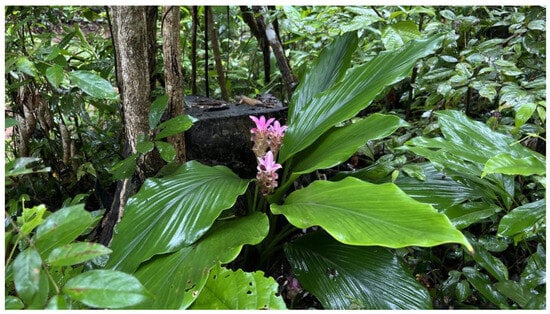
Figure 2.
Curcuma rhabdota Sirirugsa & M.F.Newman in its natural habitat, Tân Châu District, Tây Ninh Province, Vietnam (25 August 2025). Photograph by Thawatphong Boonma.

Table 2.
Key to species of Curcuma subgenus Hitcheniopsis in Vietnam.
- Additional specimens examined in Vietnam:
Curcuma alismatifolia Gagnep.: Vietnam, Tay Ninh, Lo Go Xa Mat National Park, Trang Ta Not, 13 June 2008, Trần H.Ð. 20 (E). Vietnam, Tay Ninh, Tan Chau, 25 August 2025, T.Boonma CHV001, VMSU08900082 (VMSU). Vietnam, Tay Ninh, Tan Chau, 25 August 2025, T.Boonma CHV011, VMSU08900083 (VMSU).
Curcuma campanulata (Kuntze) Škorničk.: Vietnam, Hanoi, N.Q. Binh 606 (HN). Vietnam, Quảng Ngãi, Kon Tum, L.K. Bien 570 (HN). Vietnam, Tay Ninh, Phuoc Than, C.Thorel 1222 (P).
Curcuma clovisii Škorničk.: Vietnam, Hanoi, D.H. Bich 411tA (HNPM). Vietnam, Quảng Ngãi, Kon Tum, Tap Long Tong 32 & 33 (HNPM), Vietnam, Gia Lai, Phuong, De Vi Von 108B (HNPM).
Curcuma gracillima Gagnep.: Vietnam, Dong Nai, Tan Phu Forest, Nga Tu Dong, 19 June 2008, Trần H.Ð. 48 (E). Vietnam, without precise locality, Barcode E00097678, Pierre J.B.L. s.n. (E). Vietnam, without precise locality, Barcode E00097679, Pierre J.B.L. s.n. (E).
Curcuma harmandii Gagnep.: Vietnam, Phu Tho, Hoa Binh, P.X. Truong s.n. (HNPM).
Curcuma leonidii Škorničk. & Luu: Vietnam, Dong Nai Province (Bình Phước), Bù Gia Mập National Park, Đắc Ca stream, 8 May 2012, Lưu Hồng Trương, Đinh Nhật Lâm & Võ Huy Sang LUU 807 (SGN, SING)
Curcuma pygmaea Škorničk. & Šída f.: Vietnam, Dak Lak, Ea H’Leo, 17 July 2010, Trần H.Ð. 239 (VNM).
Curcuma rhabdota Sirirugsa & M.F. Newman: Vietnam, Quảng Ngãi, Đak Na Khu Bảo Tồn, HN0000079760 (HN) (Figure 3A). Vietnam, Dak Lak Province, Dipterocarp Forest, c. 200 m a.s.l., collected by local collectors, 2019; 10 May 2024, Nguyen Van Canh, AL3130. LE 01255014 (LE).
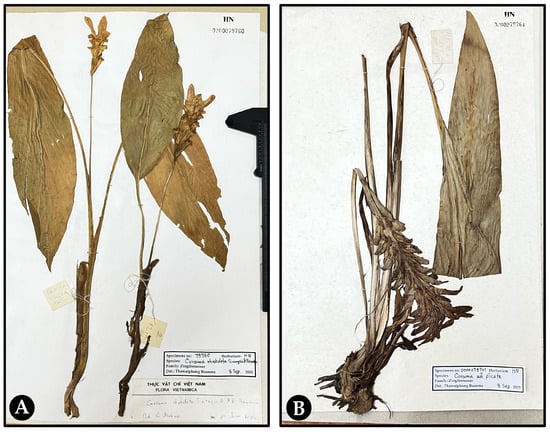
Figure 3.
Herbarium specimens: (A) Curcuma rhabdota Sirirugsa & M.F.Newman (0000079760–HN) (B) Curcuma aff. plicata (0000079761–HN) from Son La, originally identified as C. thorelii Gagnep. in the Flora of Vietnam [4], but here, re-determined as Curcuma aff. plicata based on morphological characters. Photograph taken on 8 September 2025 by Thawatphong Boonma.
Curcuma sparganiifolia Gagnep.: Vietnam, An Giang, Phu Quoc, Bai Thom Commune, Phu Quoc National Park, Dong Tram, 25 March 2018, Cao Ngọc Giang, Hà Văn Long, Lý Ngọc Sâm, Trần Thị Liên, Trần Minh Ngọc TNB-042 (VNM), ibid. TNB-044 (VNM). Vietnam, Lam Dong, Muong man, 19 October 1924, Evrard F. 1496 (P). Lam Dong, Muong man, 26 October 1924, Evrard F. 1578 (P).
Curcuma thorelii Gagnep.: Vietnam, Lam Dong, Binh Thuan, La Gi, 3 July 1925, Evrard F. 2322 (E). Hue, September 1877, Harmand F.J. 4891 (P). Dak Lak, Ea H’Leo, 17 July 2010, Trần H.Ð. 238 (SING). Dak Lak, Ban Don, Altitude 223 m, 25 June 2008 (E). Dak Lak, Ea H’Leo, 482 m, 30 July 2009, Trần H.Ð., Truong A.T. & Nguyen T.T. 178 (E).
Note on misidentified specimens: During a visit to the HN herbarium on 8 September 2025, the last author examined specimen LX-VN028, collected from Son La on 3 July 1976 and deposited at HN (Code 0000079761) (Figure 3B). This specimen had previously been identified as Curcuma thorelii Gagnep. in the Flora of Vietnam, Vol. 21, Zingiberaceae [4]. Upon careful examination, it was found that the specimen does not match C. thorelii Gagnep., as it exhibits morphological traits inconsistent with subgenus Hitcheniopsis and instead shows characters typical of subgenus Curcuma, such as the presence of two anther spurs and epigynous structures. Based on these observations, the specimen is here determined as Curcuma aff. plicata.
3.2. Traditional Uses
All ten species of Curcuma subgen. Hitcheniopsis in Vietnam, including C. alismatifolia, C. campanulata, C. clovisii, C. gracillima, C. harmandii, C. leonidii, C. pygmaea, C. rhabdota, C. sparganiifolia, and C. thorelii were cultivated either in pots or directly in the soil and were primarily used for ornamental purposes, such as garden decoration or placement around buildings and homes. Curcuma clovisii was additionally documented for traditional medicinal use; its rhizome was applied in decoctions, pastes, or as part of compound prescriptions for treating musculo-skeletal disorders, blood-related conditions, digestive and metabolic issues, nervous system ailments, and respiratory problems [4]. Most of the species served horticultural and decorative functions, while C. clovisii also demonstrated ethnomedicinal significance (Table 3).

Table 3.
Traditional uses of Curcuma subgenus Hitcheniopsis in Vietnam.
3.3. Ornamental Potential
3.3.1. Ornamental Value Index
The Ornamental Value Index (OVI) of the ten species of Curcuma subgen. Hitcheniopsis in Vietnam varied considerably, with mean values ranging from 0.460 to 0.780 (Table S2). Based on the OVI interpretation scale (0–1), all species were classified within the moderate to high ornamental value categories (Figure 4).
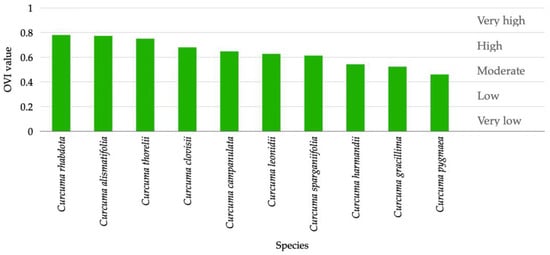
Figure 4.
Ornamental Value Index (OVI) of Curcuma subgenus Hitcheniopsis species in Vietnam, arranged from high to low OVI.
The highest mean OVI was recorded in Curcuma rhabdota (0.780 ± 0.014), followed closely by C. alismatifolia (0.773 ± 0.032) and C. thorelii (0.750 ± 0.024) (Table S2). These three species were therefore classified as having high ornamental value. Intermediate values were found in C. clovisii (0.680 ± 0.045), C. campanulata (0.647 ± 0.018), C. leonidii (0.627 ± 0.015), and C. sparganiifolia (0.613 ± 0.022), all of which also fell within the high ornamental value category. Notably, C. clovisii exhibited the widest range among the taxa, suggesting some degree of variability within the species. In contrast, C. harmandii (0.543 ± 0.009) and C. gracillima (0.523 ± 0.009) showed lower but stable scores, while C. pygmaea recorded the lowest mean OVI (0.460 ± 0.009). These three taxa were classified as having moderate ornamental value. Across the studied taxa, none were categorized as very low, low, or very high in ornamental value. The findings point to a predominance of high-value species within the sampled set, with C. rhabdota, C. alismatifolia, and C. thorelii standing out as particularly noteworthy.
3.3.2. Results of Kruskal–Wallis Test
A Kruskal–Wallis test was conducted to determine if there were statistically significant differences in the mean ranks of the OVI variable across ten different Curcuma subgen. Hitcheniopsis species in Vietnam. The test revealed a highly significant difference, with a Kruskal–Wallis H statistic of 46.298 and a p-value (Asymp. Sig.) of 0.000 (Figure 5). This result indicates that at least one of the species groups’ mean ranks is significantly different from the others. Curcuma rhabdota had the highest mean rank (45.20), while C. pygmaea had the lowest (3.00) (Figure 5).
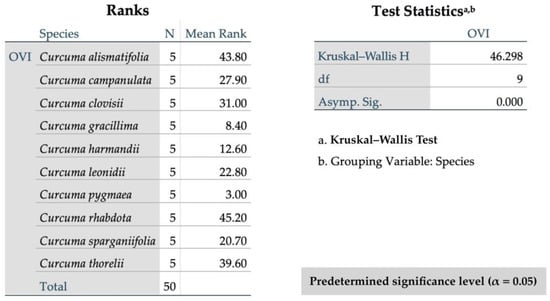
Figure 5.
Results of the Kruskal–Wallis Test on the variable OVI across ten Curcuma subgen. Hitcheniopsis species. The table of ranks shows the mean rank for each species, while the test statistics table indicates a significant difference among the groups (H = 46.298, df = 9, p = 0.000), lower than the predetermined significance level (α = 0.05).
The highly significant p-value of 0.000 (which is less than the typical alpha level of 0.05) leads us to reject the null hypothesis. The null hypothesis states that the medians of all groups are equal. Therefore, we can conclude that there are significant differences in the OVI variable among the different Curcuma subgen. Hitcheniopsis species in Vietnam.
However, since the Kruskal–Wallis test is an overall test, it is necessary to conduct post hoc pairwise comparisons using the Mann–Whitney U test.
The Kruskal–Wallis test indicated statistically significant interspecific differences in OVI values among the ten Curcuma species (H = 46.298, df = 9, p < 0.05). To visually support these findings, both a boxplot and a violin plot were constructed to illustrate the distributional patterns and rank-based variability of OVI scores across species (Figure 6). Species with visibly higher median OVI values exhibited narrower distributional spread, whereas species with lower OVI values demonstrated wider dispersion and pronounced skewness. These visual patterns are consistent with the inferential results and reinforce the presence of meaningful interspecific variation in ornamental potential.
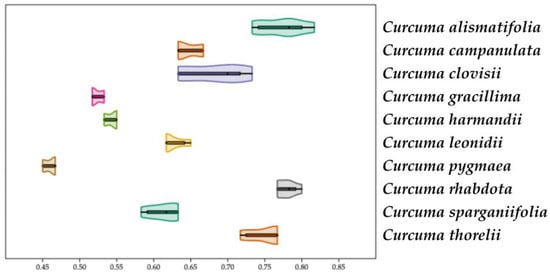
Figure 6.
Violin and box plots showing the distributional patterns and rank-based variability of Ornamental Value Index (OVI) scores across the ten Curcuma species.
The combined visualization highlights differences in central tendency, dispersion, and density structure, thereby revealing interspecific variation in ornamental attributes. Species with higher OVI scores display narrower and more concentrated distributions, whereas species with lower scores exhibit broader spread and skewness. These graphical patterns are consistent with the Kruskal–Wallis test results and reinforce the presence of statistically significant differentiation in ornamental potential among species.
3.3.3. Result of Mann–Whitney U Test
To further investigate differences in ornamental value among the ten Curcuma subgen. Hitcheniopsis species, post hoc pairwise comparisons were conducted using the Mann–Whitney U test for all 45 possible species pairs, with a predetermined significance level of α = 0.05. The Mann–Whitney U test was chosen as a non-parametric method suitable for comparing ordinal data like the Ornamental Value Index (OVI).
Most species pairs differed significantly, indicating substantial variation in OVI values across species. However, no significant differences were observed between C. alismatifolia and C. rhabdota (U = 11.000, Z = −0.324, p = 0.746) (Figure 7A), or between C. alismatifolia and C. thorelii (U = 6.500, Z = −1.277, p = 0.202) (Figure 7B), suggesting that these species have similar ornamental values. The post hoc analysis confirms that the OVI effectively distinguishes ornamental potential among most species, while the few non-significant comparisons reflect closely related species with comparable floral and inflorescence traits. These results support the reliability of OVI as a tool for horticultural evaluation, breeding selection, and conservation prioritization.
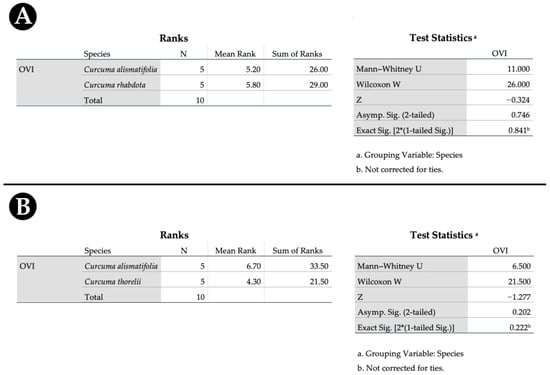
Figure 7.
Results of the Mann–Whitney U test comparing the Ornamental Value Index (OVI): (A) Mann–Whitney U test between Curcuma alismatifolia and C. rhabdota; (B) Mann–Whitney U test between C. alismatifolia and C. thorelii. Mean ranks, sum of ranks, U values, Z scores, and significance levels (2-tailed) are presented for each comparison. No significant differences were found at a predetermined significance level of α = 0.05. * indicates that the Exact Sig. value is calculated as 2 × (1-tailed Sig.).
The Mann–Whitney U test results support the reliability of the Ornamental Value Index (OVI) by demonstrating that most pairwise comparisons among the ten Curcuma subgen. Hitcheniopsis species differed significantly, confirming that the OVI effectively reflects variation in ornamental traits. The few non-significant differences, such as between C. alismatifolia and C. rhabdota or C. thorelii, indicate that these species possess similar ornamental features. These findings validate the OVI as a meaningful tool for distinguishing ornamental potential among species and provide important insights for their horticultural evaluation, breeding, and conservation planning.
The dendrogram derived from the raw OVI scores (Figure 8) revealed distinct clustering among the Curcuma species according to ornamental similarity. Species with high OVI values, such as C. alismatifolia and C. rhabdota, consistently clustered together, reflecting their prominently expressed floral traits and well-balanced aesthetic profiles. In contrast, species with moderate to low OVI values (e.g., C. gracillima, C. pygmaea) formed separate clusters, corresponding to their relatively inconspicuous floral and vegetative characters. Notably, C. sparganiifolia appeared as a discrete subgroup despite high scores on certain traits, likely due to divergence in inflorescence architecture or peduncle morphology. Overall, the cluster structure corroborates the ability of the OVI to differentiate species based on both aggregate ornamental merit and trait-specific variation.
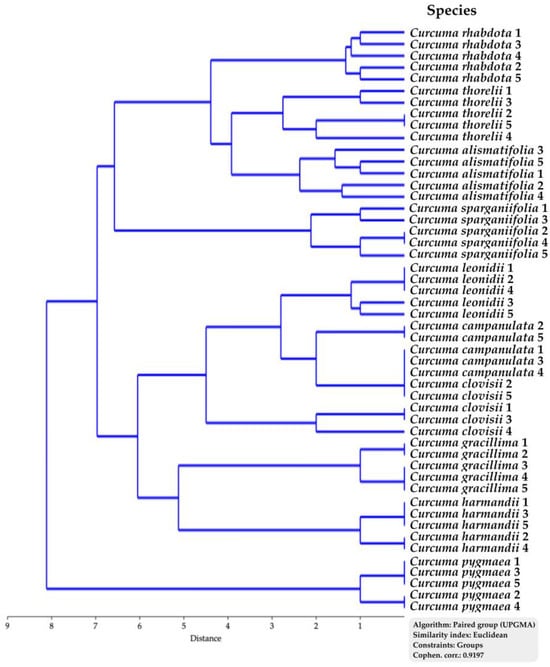
Figure 8.
Dendrogram of Curcuma spp. based on Ornamental Value Index (OVI) raw scores. Clustering was performed using UPGMA with Euclidean distance, revealing groups with similar flower and leaf traits. Cophenetic correlation = 0.9197.
3.4. Potential Distribution Modelling
The modelling results for the Curcuma subgen. Hitcheniopsis demonstrate high predictive performance and excellent discriminatory ability, with an average AUC of 0.9475. Under current climatic conditions, the model estimates that suitable habitats for Curcuma subgen. Hitcheniopsis are concentrated across large areas of mainland Southeast Asia, particularly in Thailand, Laos, Vietnam, Cambodia, and Myanmar. Substantial suitable regions are also projected in southern China, extending from Yunnan and Guangxi Provinces eastward along the subtropical belt. Additional suitable habitats are identified in parts of the Philippines and the Indonesian archipelago, including Java and Sulawesi (Figure 9).
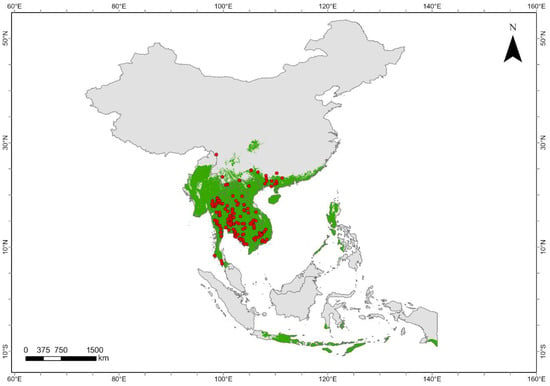
Figure 9.
Estimated potential distribution of the Curcuma subgenus Hitcheniopsis in Southeast Asia and China under current climatic conditions. Areas in green represent suitable habitat, whereas grey areas represent unsuitable habitat. Points denote known occurrence records.
The predicted areas extend beyond currently documented localities, highlighting regions that may harbor yet-undiscovered populations. For example, the model identifies suitable habitats in northern Myanmar and island regions such as Sumatra and Java, where field records remain scarce or absent. This indicates that targeted field surveys in these areas may reveal previously undocumented populations, thereby contributing to a more comprehensive understanding of the subgenus’ distribution.
The potential distribution modeling for Curcuma subgen. Hitcheniopsis strongly supports this study, particularly in Vietnam, by identifying areas with high habitat suitability and providing a predictive framework for discovering new populations. The model, which achieved an average AUC of 0.9475, highlights regions with suitable climatic conditions that extend beyond known localities, indicating areas likely to harbor previously undocumented populations. Notably, field surveys in Vietnam confirmed a new record, C. rhabdota, in Tay Ninh within one of the predicted suitable regions, validating the model’s accuracy and demonstrating its practical value for guiding future exploration. These results not only corroborate observed distribution patterns in Vietnam but also enhance understanding of the subgenus’ ecological preferences and potential range across the region, and suggest that new species may potentially be discovered in the future.
3.5. Conservation Status Assessment
The conservation assessment of species within the Curcuma subgenus Hitcheniopsis was conducted following the IUCN Red List criteria. As shown in the distribution modelling results (Section 3.3), suitable habitats extend across broader areas of Southeast Asia and southern China than currently documented, suggesting the possibility of undiscovered populations. However, in the absence of confirmed field records from these predicted regions, threat evaluations must rely primarily on verified occurrences.
Most species of Curcuma subgenus Hitcheniopsis exhibit narrow distribution ranges; e.g., C. leonidii and C. pygmaea, which are endemic to Vietnam, are often restricted to specific habitats that are subject to ongoing threats such as agricultural expansion, infrastructure development, and habitat degradation. These pressures highlight the vulnerability of the subgenus, particularly for species with few known localities (Figure 10).
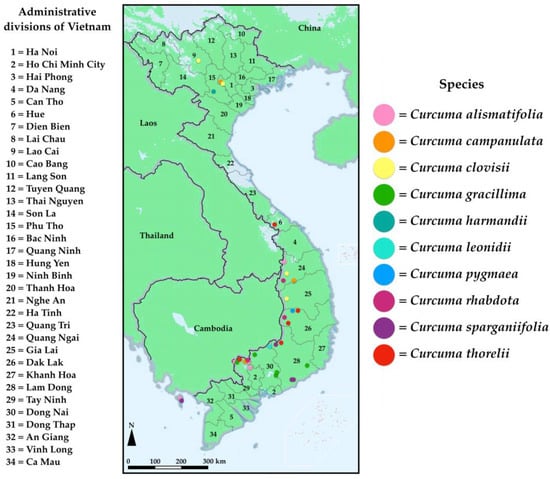
Figure 10.
Distribution map of ten species of Curcuma subgenus Hitcheniopsis in Vietnam. Areas in green represent suitable habitats, whereas grey areas indicate unsuitable habitats.
The integration of predictive modelling with field data provides a more comprehensive perspective, but until further surveys are undertaken, the conservation status of each species should be assessed cautiously. Preliminary conservation categories for each taxon are summarized in Table 4.

Table 4.
Conservation Status Assessment of Curcuma subgenus Hitcheniopsis in Vietnam.
The conservation assessment of Curcuma subgenus Hitcheniopsis in Vietnam shows varying levels of risk. C. harmandii and C. thorelii are Least Concern (LC), while C. alismatifolia, C. campanulata, C. clovisii, and C. gracillima are Near Threatened (NT) due to small, scattered populations and habitat disturbance. Endemic species C. leonidii and C. pygmaea are Critically Endangered (CR) with extremely limited ranges, whereas C. rhabdota is Vulnerable (VU) and C. sparganiifolia is Endangered (EN) owing to small population sizes and ongoing threats.
3.6. Tips for Cultivating Curcuma Subgenus Hitcheniopsis as Pot Plants
Based on the ecological preferences, flowering periods, and dormancy patterns observed for the species in Vietnam, the following guidelines are recommended for successful pot cultivation:
- Potting and soil: Use well-drained, sandy-loamy or peat-based substrates in pots with adequate drainage holes to prevent rhizome rot.
- Light: During the active growing phase, most species of Curcuma subgenus Hitcheniopsis thrive in partial sunlight. Curcuma alismatifolia, C. campanulata, C. clovisii, C. gracillima, C. pygmaea, C. sparganiifolia, and C. thorelii generally tolerate bright, filtered light. Curcuma harmandii and C. rhabdota prefer moderately shaded conditions, while C. leonidii grows best under low to moderate light levels.
- Watering: Provide consistent moisture while plants are actively growing, avoiding waterlogging. Reduce watering during dormancy to prevent rhizome decay.
- Fertilization: Apply a balanced liquid or slow-release fertilizer every 3–4 weeks during the growing season to enhance leaf and inflorescence development.
- Temperature: Maintain warm conditions during growth and avoid prolonged exposure to cold, as tropical species may become stressed.
- Dormancy management: Allow foliage to naturally senesce in winter. Rhizomes can remain in the pot or be lifted and stored in slightly moist substrate in a cool, shaded location until the next growth cycle.
Propagation: The most practical method for pot cultivation is rhizome or new shoot division. For large-scale propagation or hybrid production, tissue culture can be employed. These approaches help maximize flowering and ornamental display, while respecting the plants’ natural seasonal cycles and promoting sustainable cultivation practices.
4. Discussion
In Vietnam, ten species of Curcuma subgenus Hitcheniopsis were identified, including two endemics (C. leonidii and C. pygmaea) [30,31]. Notably, C. rhabdota was recorded for the first time in the country, extending its known range and suggesting the possibility of other undocumented populations [4,49]. Most species were observed in deciduous dipterocarp and dry evergreen forests [4], highlighting clear habitat preferences and the importance of these forest types for regional biodiversity. Most species, including C. alismatifolia, C. gracillima, C. harmandii, C. pygmaea, C. rhabdota, C. sparganiifolia, and C. thorelii, flower from July to September, coinciding with the peak of the rainy season. Early flowering species, such as C. campanulata and C. clovisii [4], which produce lateral inflorescences, flower from April to May, likely reflecting inflorescence position and habitat effects. In contrast, C. leonidii [31], which produces a terminal inflorescence and occurs in dry evergreen forests, flowers earlier, from April to June, likely due to microclimatic differences such as light and soil moisture. This temporal separation highlights phenological niche differentiation, reducing interspecific competition and supporting species coexistence. These patterns are valuable for conservation planning, targeted surveys, and ornamental utilization.
Accurate species identification is essential for reliable taxonomic studies, as it ensures that morphological data, distribution records, and evolutionary relationships are correctly interpreted. Careful verification of herbarium specimens strengthens the foundation of systematic research and supports consistent biodiversity assessments. For example, specimen LX-VN028 from Son La was previously identified as Curcuma thorelii [4], but detailed morphological examination revealed traits characteristic of subgenus Curcuma rather than subgenus Hitcheniopsis. Correctly recognizing this specimen as Curcuma aff. plicata not only clarifies its true taxonomic placement but also highlights the value of revisiting historical collections to improve the accuracy of floristic and evolutionary studies.
The confirmation of Curcuma rhabdota in Vietnam provides a significant contribution to botanical knowledge. While the species has been mentioned in broader Indochinese records, no verified specimens from Vietnam existed until this study. The specimen from Tây Ninh Province now establishes its presence in the national flora and strengthens the accuracy of regional inventories. Verified specimens serve as essential references for future taxonomic, ecological, and ethnobotanical research, ensuring that conservation measures and sustainable management plans rely on correctly identified populations. Furthermore, authentic plant material can support ornamental cultivation, breeding programs, and studies of bioactive compounds, effectively connecting field taxonomy to applied research.
Species distribution modeling revealed that suitable habitats for Curcuma subgenus Hitcheniopsis extend beyond the currently documented locations in Vietnam [4], covering parts of Southeast Asia and southern China [38,49]. These predictions indicate areas where undiscovered populations may occur and highlight landscapes that could be prioritized for conservation or ex situ cultivation. Habitat modeling thus provides practical guidance for targeted field surveys and planning sustainable use [46,47,48].
All documented species showed moderate to high decorative value. Curcuma rhabdota, C. alismatifolia, and C. thorelii scored the highest in the Ornamental Value Index (OVI). Statistical tests (Kruskal–Wallis and Mann–Whitney U) confirmed significant differences in OVI among most species, while some closely related taxa had similar values, reflecting shared morphological traits. Species with high OVI have already been used as parents in hybrid production in Thailand, including Curcuma hybrid ‘Chocolate’ (C. harmandii × (C. alismatifolia × C. rhabdota), ‘Maejo Elite’ (C. rhabdota × C. alismatifolia), and ‘Chiang Rai CF3’ (C. alismatifolia × C. thorelii) [53]. These examples illustrate the practical potential of high-OVI species for horticultural breeding, commercial propagation, and ornamental landscaping.
The Ornamental Value Index of Curcuma species was strongly influenced by floral and inflorescence characteristics. Species with high OVI values, such as C. alismatifolia, C. rhabdota, and C. thorelii, consistently exhibited large and showy flowers with prominent color contrast, high flower abundance, and well-developed coma and fertile bracts. Additionally, these species displayed tall peduncles and moderately long thyrses, which elevated the inflorescence above the foliage and enhanced visual prominence. Leaf size and color contributed to overall aesthetic balance, but the primary drivers of high OVI were floral traits and the distinctive appearance of the inflorescence. In particular, the combination of floral display, structural balance, and unique or rare visual features rendered these species most attractive, indicating that aesthetic and rarity-related traits play a central role in shaping the ornamental potential of Curcuma species.
However, this study is limited by the small sample size per species. Consequently, the current Ornamental Value Index (OVI) results should be considered preliminary and require further verification through larger-scale cultivation experiments with more individuals per species.
Although most species are cultivated primarily for ornamental purposes, some, such as C. clovisii, are known for traditional medicinal uses. Additionally, several species in Vietnam have been investigated for bioactive compounds and pharmacological activities, including volatile constituents of C. harmandii [54]; antioxidant and antidiarrheal properties of C. alismatifolia leaves [55]; antimicrobial compounds from rhizomes of C. rhabdota, C. thorelii, and C. petiolata [40]; essential oil components and antibacterial activity of C. pygmaea [56]; volatile leaf oils of C. thorelii [57]; and acetone extracts of C. thorelii [58]. These findings indicate that even species without documented traditional medicinal uses may possess valuable bioactive properties, emphasizing the subgenus’ significance for both pharmacological and horticultural applications.
Flowering periods among Hitcheniopsis species in Vietnam range from April to September (Table 1), with each species exhibiting distinct timing. For example, C. campanulata and C. clovisii flower in April–May, while C. alismatifolia, C. gracillima, C. harmandii, C. pygmaea, C. rhabdota, C. sparganiifolia, and C. thorelii flower from July to September, and C. leonidii blooms from April to June. All species enter a pronounced dormancy during cooler winter months, when above-ground shoots senesce and rhizomes remain inactive. Recognizing these dormancy patterns is critical for successful ornamental cultivation, as it guides watering, fertilization, and propagation schedules. Proper management of light and temperature during dormancy ensures rhizome health and supports vigorous regrowth, enabling synchronized flowering and optimal display in pots.
To prevent overexploitation, all species of Curcuma subgenus Hitcheniopsis require sustainable management. Conservation measures should include ex situ cultivation, reduced collection from natural habitats, and promotion of sustainable use practices. Unprotected areas could be designated as Other Effective area-based Conservation Measures (OECMs) [28,59,60] to maintain long-term population stability and support horticultural use. By integrating field surveys, species distribution modeling, ornamental assessment, and ethnobotanical data, this study provides a practical framework for conservation, sustainable horticulture, and the broader biological understanding of Curcuma subgenus Hitcheniopsis in Vietnam and Southeast Asia.
5. Conclusions
This study provides a comprehensive assessment of the diversity, traditional uses, ornamental potential, distribution, and conservation status of Curcuma subgenus Hitcheniopsis in Vietnam. A total of ten species were documented, including two endemic species (C. leonidii and C. pygmaea), and one species (C. rhabdota) newly recorded for the Vietnamese flora, expanding knowledge of its regional distribution. Species-specific flowering periods and dormancy patterns were characterized, which are crucial for successful ornamental cultivation, particularly in potted settings. Ornamental Value Index (OVI) analysis revealed significant variation among species, with C. rhabdota, C. alismatifolia, and C. thorelii demonstrating the highest ornamental potential. These high-value species have already been utilized in hybridization programs in Thailand to produce new Curcuma cultivars. Although most species are primarily cultivated for ornamental purposes, several have been investigated for bioactive compounds and pharmacological properties, highlighting their potential for ethnomedicinal and biotechnological applications. Distribution modeling identified extensive suitable habitats across Southeast Asia, indicating the possibility of undiscovered populations. However, many species remain vulnerable due to habitat loss, limited range, and potential overharvesting. Sustainable cultivation practices, including pot cultivation, propagation, and dormancy management, are essential to minimize pressure on wild populations. The findings underscore the importance of integrating field surveys, ecological modeling, and horticultural practices to support both conservation and sustainable utilization of Curcuma subgenus Hitcheniopsis in Vietnam.
Supplementary Materials
The following supporting information can be downloaded at https://www.mdpi.com/article/10.3390/d17110778/s1. Table S1: Evaluation traits and subtraits used for the preliminary assessment of ornamental value; Table S2: Ornamental Value Index of each individual and species of Curcuma subgen. Hitcheniopsis in Vietnam.
Author Contributions
Conceptualization, P.S., S.S., M.T.P.T., N.T., P.R., S.P. and T.B.; methodology, P.S., S.S., M.T.P.T., N.T., P.R., S.P. and T.B.; software, N.T., P.R. and T.B.; validation, P.S., S.S., M.T.P.T., S.P. and T.B.; formal analysis, P.S., S.S., M.T.P.T., N.T., P.R., S.P. and T.B.; investigation, M.T.P.T., S.P. and T.B.; resources, M.T.P.T., S.P. and T.B.; data curation, T.B.; writing—original draft preparation, T.B.; writing—review and editing, P.S., S.S., M.T.P.T., N.T., P.R., S.P. and T.B.; visualization, T.B.; supervision, P.S., S.S. and M.T.P.T.; project administration, S.S., P.S. and T.B.; funding acquisition, S.S. and T.B. All authors have read and agreed to the published version of the manuscript.
Funding
This research project was financially supported by Mahasarakham University (The International Research Network Development Grant for Students 2025 (6819001/2568)).
Institutional Review Board Statement
Not applicable.
Informed Consent Statement
Not applicable.
Data Availability Statement
The original contributions presented in this study are included in the article; further inquiries can be directed to the corresponding author.
Acknowledgments
The authors sincerely acknowledge Mahasarakham University for their funding support, particularly the Division of Research Facilitation and Dissemination, for the International Research Network Development Grant for Students 2025 (6819001/2568). The authors are also grateful to Tran Thi Phuong Thao, Danh Duc Nguyen, and Viet Ha for their assistance during the field trip in Vietnam. Furthermore, the authors wish to acknowledge the invaluable support of the curators of all herbaria visited in Vietnam, especially Dang Van Son, Nguyen Thi Mai Huong, Do Van Hai, and Nguyen Thi Kim Thanh, as well as those referenced elsewhere in this study. Appreciation is also extended to Nguyen Hoang Tuan and the Faculty of Pharmacognosy and Traditional Medicine, Hanoi University of Pharmacy, and the Walai Rukhavej Botanical Research Institute.
Conflicts of Interest
The authors declare no conflicts of interest.
Abbreviations
The following abbreviations are used in this manuscript:
| BK | Bangkok Herbarium, Department of Agriculture, Thailand |
| BKF | Department of National Parks, Wildlife and Plant Conservation, Thailand |
| E | Royal Botanic Garden Edinburgh, Edinburgh, United Kingdom |
| HN | Vietnam Academy of Science and Technology (VAST), Hanoi, Vietnam |
| HNPM | National Institute of Medicinal Materials, Vietnam |
| HNU | VNU University of Science, Hanoi, Vietnam |
| IBK | Guangxi Institute of Botany, China |
| IMDY | Chinese Academy of Medical Sciences, China |
| K | Royal Botanic Gardens, United Kingdom |
| KKU | Khon Khan University Herbarium, Thailand |
| P | Muséum National d’Histoire Naturelle, Paris, France |
| QBG | Queen Sirikit Botanic Garden, The Botanical Garden Organization, Thailand |
| SGN | Southern Institute of Ecology, Ho Chi Minh City, Vietnam |
| SING | National Parks Board, Singapore |
| VMSU | Vascular Plant Herbarium, Mahasarakham University, Thailand |
| VNM | Institute of Tropical Biology, Ho Chi Minh City, Vietnam |
| VNMN | Vietnam National Museum of Nature, Hanoi, Vietnam |
References
- Leong-Škorničková, J.; Šída, O.; Záveská, E.; Marhold, K. History of infrageneric classification, typification of supraspecific names and outstanding transfers in Curcuma (Zingiberaceae). Taxon 2015, 64, 362–373. [Google Scholar] [CrossRef]
- Záveská, E.; Fér, T.; Šída, O.; Krak, K.; Marhold, K.; Leong-Škorničková, J. Phylogeny of Curcuma (Zingiberaceae) based on plastid and nuclear sequences: Proposal of the new subgenus Ecomata. Taxon 2012, 61, 747–763. [Google Scholar] [CrossRef]
- Leong-Škorničková, J.; Newman, M. Gingers of Cambodia, Laos & Vietnam; Singapore Botanic Gardens, National Parks Board in association with Royal Botanic Garden Edinburgh & Pha Tad Ke Botanical Garden: Singapore, 2015.
- Nguyen, Q.B. Stahlianthus and Curcuma. In Flora of Vietnam, Vol. 21, Zingiberaceae Lindl.; Le, P.L., Nguyen, V.V., Eds.; Ministry of Science and Technology and Vietnam Academy of Science and Technology: Hanoi, Vietnam, 2017; pp. 217–261. [Google Scholar]
- Wu, D.; Larsen, K. (Eds.) Zingiberaceae. In Flora of China; Harvard University Herbaria: Cambridge, MA, USA, 2025; Volume 24, Available online: http://www.efloras.org/florataxon.aspx?flora_id=2&taxon_id=10960 (accessed on 1 August 2025).
- Leong-Škorničková, J.; Saensouk, S. Curcuma L. In Flora of Thailand; Newman, M.F., Barfod, A.S., Esser, H.J., Simpson, D., Parnell, J.A.N., Eds.; The Forest Herbarium, Department of National Parks, Wildlife and Plant Conservation: Bangkok, Thailand, 2023; Volume 16, pp. 415–476. [Google Scholar]
- Saensouk, S.; Boonma, T.; Saensouk, P. Six new species and a new record of Curcuma L. (Zingiberaceae) from Thailand. Biodiversitas 2021, 22, 1658–1685. [Google Scholar] [CrossRef]
- Boonma, T.; Saensouk, S.; Saensouk, P. Diversity and Traditional Utilization of the Zingiberaceae Plants in Nakhon Nayok Province, Central Thailand. Diversity 2023, 15, 904. [Google Scholar] [CrossRef]
- Boonma, T.; Saensouk, S.; Saensouk, P. Biogeography, Conservation Status, and Traditional Uses of Zingiberaceae in Saraburi Province, Thailand, with Kaempferia chaveerachiae sp. nov. Horticulturae 2024, 10, 934. [Google Scholar] [CrossRef]
- Saensouk, P.; Saensouk, S.; Maknoi, C.; Song, D.; Boonma, T. Curcuma nivea (Zingiberaceae), a New Compact Species with Horticultural Potential from Eastern Thailand. Horticulturae 2025, 11, 908. [Google Scholar] [CrossRef]
- Liên, L.; Cao, N.; Ngoc, M.N.; Nguyen, M.; Ha, V.; Ly, S. First record of Curcuma sparganiifolia Gagnep. (Zingiberaceae) from Vietnam. Biosci. Discov. 2019, 10, 10–15. Available online: https://jbsd.in/Vol%2010%20No%201/ThiLien10-15.pdf (accessed on 17 August 2025).
- Saensouk, P.; Saensouk, S.; Chanthavongsa, K.; Sengthong, A.; Phengmala, K.; Maknoi, C.; Rakarcha, S.; Boonma, T. Seven New Records of Curcuma L. (Zingiberaceae) for the Flora of Laos: Implications for Biodiversity Conservation and Sustainable Horticulture. Horticulturae 2025, 11, 720. [Google Scholar] [CrossRef]
- Mai, T.; Tran, T.T.N.; Nguyễn, T.; Mai, Đ.; Nguyễn, D. Curcuma daknongensis (Zingiberaceae), a New Species from Southern Vietnam. Ann. Bot. Fenn. 2025, 62, 119. [Google Scholar] [CrossRef]
- Hwang, S.; Lee, P.; Choi, M.; Kim, Y. Inflorescence development of Curcuma alismatifolia ‘Chiangmai Pink’. Korean J. Hortic. Sci. Technol. 2014, 32, 623–627. [Google Scholar] [CrossRef]
- Ruamrungsri, S. The physiology of Curcuma alismatifolia Gagnep. as a basis for the improvement of ornamental production. Eur. J. Hortic. Sci. 2015, 80, 316–321. [Google Scholar] [CrossRef]
- Sirirugsa, P.; Newman, M. A new species of Curcuma L. (Zingiberaceae) from S.E. Asia. New Plantsman 2000, 7, 196–199. [Google Scholar]
- Ye, Y.; Zhou, Y.; Tan, J.; Zhu, G.; Liu, J.; Xu, Y. Cross-Compatibility in Interspecific Hybridization of Different Curcuma Accessions. Plants 2023, 12, 1961. [Google Scholar] [CrossRef] [PubMed]
- Ketmaro, S.; Taychasinpitak, T.; Mongkolchaiyaphruek, A.; Wongchaochant, S. Effect of colchicine on increasing pollen viability in a Curcuma hybrid (Curcuma sparganiifolia × C. parviflora). Kasetsart J. Nat. Sci. 2012, 46, 363–370. [Google Scholar]
- Taheri, S.; Abdullah, T.L.; Rafi, M.Y.; Harikrishna, J.A.; Werbrouck, S.P.O.; Teo, C.H.; Sahebi, M.; Azizi, P. De novo assembly of transcriptomes, mining, and development of novel EST-SSR markers in Curcuma alismatifolia (Zingiberaceae family) through Illumina sequencing. Sci. Rep. 2019, 9, 3047. [Google Scholar]
- Newman, M.F. Distichochlamys, a new genus from Vietnam. Edinburgh J. Bot. 1995, 52, 65–69. [Google Scholar] [CrossRef]
- Rehse, T.; Kress, W.J. Distichochlamys rubrostriata (Zingiberaceae), a new species from Northern Vietnam. Brittonia 2003, 55, 205–208. [Google Scholar] [CrossRef]
- Larsen, K.; Newman, M. A new species of Distichochlamys from Vietnam and some observations on generic limits in Hedychiae (Zingiberaceae). Nat. Hist. Bull. Siam Soc. 2001, 49, 77. [Google Scholar]
- Nguyen, Q.B.; Leong-Škorničková, J. Distichochlamys benenica (Zingiberaceae), a new species from Vietnam. Gard. Bull. Singap. 2012, 64, 195–200. [Google Scholar]
- Leong-Škorničková, J.; Lý, N.S.; Poulsen, A.D.; Tosh, J.; Forrest, A. Newmania: A new ginger genus from central Vietnam. Taxon 2011, 60, 1386–1396. [Google Scholar] [CrossRef]
- Lưu, H.T.; Leong-Škorničková, J.; Nguyễn, L.X.B.; Ðỗ, C.T.; Hoàng, T.T. Newmania sessilanthera (Zingiberaceae): A new species from Vietnam. Gard. Bull. Singap. 2015, 67, 351–355. [Google Scholar] [CrossRef]
- Tran, H.; Dang, H.T.; Trần, N.; Nguyễn, T.; Binh, N.; Leong-Škorničková, J. Three new Newmania species (Zingiberaceae: Zingibereae) from central Vietnam. Phytotaxa 2018, 367, 145–157. [Google Scholar] [CrossRef]
- IUCN. Guidelines for Using the IUCN Red List Categories and Criteria, Version 16. 2024. Available online: https://nc.iucnredlist.org/redlist/content/attachment_files/RedListGuidelines.pdf (accessed on 1 July 2025).
- IUCN-WCPA. IUCN-WCPA Task Force on OECMs: Recognising and Reporting Other Effective Area-Based Conservation Measures; IUCN: Gland, Switzerland, 2019. [Google Scholar]
- Nguyen, K. 2025. Available online: https://commons.wikimedia.org/wiki/File:Vietnam_location_map_coloured.svg (accessed on 1 July 2025).
- Leong-Škorničková, J.; Šída, O.; Trần, H.Đ. Curcuma pygmaea sp. nov. (Zingiberaceae) from Vietnam and Notes on Two Related Species C. parviflora and C. thorelii. Nordic J. Bot. 2014, 32, 119–127. [Google Scholar] [CrossRef]
- Leong-Škorničková, J.; Luu, H.T. Curcuma leonidii, a New Species from Southern Vietnam. Phytotaxa 2013, 126, 37–72. [Google Scholar] [CrossRef]
- Nguyen, D.D.; Le, T.A.; Hoang, Q.H.; Le, Q.T.; Nguyen, E. Two new taxa of Curcuma subgen. Ecomata (Zingiberaceae: Zingibereae), from coastal Central Vietnam. Biodiversitas 2022, 23, 2512–2519. [Google Scholar]
- Nguyen, H.T.; Nguyen, N.A.; Averyanov, L.; Nguyen, D.D.; Le, C.T. Curcuma tuanii (Zingiberaceae), a New Species of Subgenus Ecomata from Northern Vietnam Based on Morphological and Molecular Evidence. Acta Bot. Bras. 2023, 37, e20230028. [Google Scholar] [CrossRef]
- Leong-Škorničková, J.; Lý, N.S. Curcuma pambrosima sp. nov. (Zingiberaceae) from central Vietnam. Nord. J. Bot. 2010, 28, 652–655. [Google Scholar] [CrossRef]
- Leong-Škorničková, J.; Trần, H.Ð.; Newman, M.F. Curcuma vitellina (Zingiberaceae), a new species from Vietnam. Gard. Bull. Singap. 2010, 62, 111–117. [Google Scholar]
- Saensouk, P.; Boonma, T.; Maknoi, C.; Saensouk, S. Curcuma ubonensis (Zingiberaceae), a new species of Curcuma subgen. Hitcheniopsis from Eastern Thailand. Notul. Bot. Horti Agrobo. Cluj-Napoca 2023, 51, 13374. [Google Scholar] [CrossRef]
- Maknoi, C.; Jenjittikul, T. A new species of Curcuma L. (Zingiberaceae) from Southeast Asia. Gard. Bull. Singap. 2006, 58, 41–46. [Google Scholar]
- GBIF.org. GBIF Occurrence Download. Available online: https://doi.org/10.15468/dl.pckfpm (accessed on 16 August 2025).
- Chen, T.V.; Lam, D.N.X.; Thong, C.L.T.; Nguyen, D.D.; Nhi, N.T.T.; Triet, N.T. Morphological Characters, Pharmacognostical Parameters, and Preliminary Phytochemical Screening of Curcuma sahuynhensis Škorničk. & N.S.Lý in Quang Ngai Province, Vietnam. Biodiversitas 2022, 23, 3907–3920. [Google Scholar] [CrossRef]
- Tran-Trung, H.; Dau, X.D.; Nguyen, T.C.; Nguyen-Thi-Thu, H.; Nguyen-Ngoc, H.; Nguyen, T.G.A.; Hoang, V.T.; Nguyen, D.-K.; Nguyen, D.D.; Tran Van, C.; et al. Phytochemical Analysis of the Essential Oils from the Rhizomes of Three Vietnamese Curcuma Species and Their Antimicrobial Activity. Nat. Prod. Commun. 2023, 18, 1–8. [Google Scholar] [CrossRef]
- iNaturalist. Observations of Curcuma [Dataset]. iNaturalist.org. 2025. Available online: https://www.inaturalist.org/observations?nelat=23.3926504&nelng=109.6765&subview=map&swlat=8.1952001&swlng=102.1439665&taxon_id=119267&utm_source=chatgpt.com (accessed on 16 August 2025).
- Retana-Cordero, M.; Fisher, P.R.; Gómez, C. Modeling the Effect of Temperature on Ginger and Turmeric Rhizome Sprouting. Agronomy 2021, 11, 1931. [Google Scholar] [CrossRef]
- Hagiladi, A.; Umiel, N.; Yang, X.-H. Curcuma alismatifolia II. Effects of temperature and daylength on the development of flowers and propagules. Acta Hortic. 1997, 430, 755–761. [Google Scholar] [CrossRef]
- Inkham, C.; Sueyoshi, K.; Ohtake, N.; Ohyama, T.; Ruamrungsri, S. Effects of temperature and nitrogen sources on growth and nitrogen assimilation of Curcuma alismatifolia Gagnep. Thai J. Agric. Sci. 2011, 44, 145–153. [Google Scholar]
- Hongpakdee, P.; Ohtake, N.; Sueyoshi, K.; Ohyama, T.; Ruamrungsri, S. Effects of low night temperature and short day length on some phytohormones and nutrient status in Curcuma alismatifolia Gagnep. Thai J. Agric. Sci. 2010, 43, 163–173. [Google Scholar]
- Phillips, S.J.; Anderson, R.P.; Schapire, R.E. Maximum entropy modeling of species geographic distributions. Ecol. Model. 2006, 190, 231–259. [Google Scholar] [CrossRef]
- Barbet-Massin, M.; Jiguet, F.; Albert, C.H.; Thuiller, W. Selecting pseudo-absences for species distribution models: How, where and how many? How to use pseudo-absences in niche modelling? Methods Ecol. Evol. 2012, 3, 327–338. [Google Scholar] [CrossRef]
- Liu, C.; Newell, G.; White, M. On the selection of thresholds for predicting species occurrence with presence-only data. Ecol. Evol. 2015, 6, 337–348. [Google Scholar] [CrossRef]
- Plants of the World Online. Royal Botanic Gardens, Kew. Available online: https://powo.science.kew.org (accessed on 16 August 2025).
- IPNI. The Royal Botanic Gardens, Kew, Harvard University Herbaria & Libraries, and Australian National Herbarium. Available online: http://www.ipni.org (accessed on 16 August 2025).
- Index Herbariorum. Available online: https://sweetgum.nybg.org/science/ih/ (accessed on 16 August 2025).
- IUCN. The IUCN Red List of Threatened Species. Version 2025-1. Available online: https://www.iucnredlist.org (accessed on 1 September 2025).
- Department of Agriculture, Thailand. Curcuma Flowering Plants (Pathumma Hybrids). 2019. Available online: https://www.doa.go.th/pvp/wp-content/uploads/2019/11/AnnoDOA_Public121.pdf (accessed on 1 September 2025).
- Dũng, N.; Truong, P.X.; Ky, P.T.; Leclercq, P.A. Volatile constituents of the leaf, stem, rhizome, root and flower oils of Curcuma harmandii Gagnep. from Vietnam. J. Essent. Oil Res. 1997, 9, 677–681. [Google Scholar] [CrossRef]
- Akter, R.; Hasan, S.M.R.; Hossain, M.M.; Jamila, M.; Chowdhury, S.S.; Mazumder, M.E.H.; Rahman, S. Antidiarrhoeal and Antioxidant Properties of Curcuma alismatifolia Leaves. Aust. J. Basic Appl. Sci. 2010, 4, 450–456. Available online: https://www.ajbasweb.com/old/ajbas/2010/450-456.pdf (accessed on 1 September 2025).
- Dinh, Q.D.; Nguyen, N.A.; Pham, T.V.; Van, H.T.; Nguyen, Q.H.; Le, T.T.; Nguyen-Phi, N. Essential Oil from the Aerial Parts of Curcuma pygmaea: Components and Antibacterial Activity. Chem. Nat. Compd. 2023, 59, 966–967. [Google Scholar] [CrossRef]
- Tran-Trung, H.; Giang, L.D.; Duc, D.X.; Giang An, N.T.; Van Son, D.; Vu, D.C.; Anh, N.T.K.; Nguyen-Thi-Thu, H.; Tam, K.T.; Nguyen, T.H. Volatile Constituents and In Vitro Antimicrobial Activities of Essential Oils from Leaves of Siliquamomum oreodoxa N.S. Lý & Škorničk and Curcuma thorelii Gagnep. (Zingiberaceae) Growing in Vietnam. J. Biol. Act. Prod. Nat. 2023, 13, 145–155. [Google Scholar] [CrossRef]
- Van, T.; Tran, M.; Tran, T.; Nguyen, H.; Nguyen, A.; Huynh, N.; Le, V.; Nguyen, Q.; Le, T.; Phi, N.; et al. Chemical Profiles and Antibacterial Activity of Acetone Extract of Two Curcuma Species from Vietnam. Plant Sci. Today 2023, 10, 83–89. [Google Scholar] [CrossRef]
- SCBD. SCBD UNEP/CBD/COP/DEC/X/2 Decision Adopted by the Conference of the Parties to the Convention on Biological Diversity at Its Tenth Meeting: X/2 The Strategic Plan for Biodiversity 2011–2020 and the Aichi Biodiversity Targets. 2010. Available online: https://www.cbd.int/decision/cop/default.shtml?id=12268 (accessed on 1 July 2025).
- Convention on Biological Diversity. Decision 14/8, ‘Protected Areas and Other effective Area-Based Conservation Measures’; Convention on Biological Diversity: Montreal, QC, Canada, 2018. [Google Scholar]
Disclaimer/Publisher’s Note: The statements, opinions and data contained in all publications are solely those of the individual author(s) and contributor(s) and not of MDPI and/or the editor(s). MDPI and/or the editor(s) disclaim responsibility for any injury to people or property resulting from any ideas, methods, instructions or products referred to in the content. |
© 2025 by the authors. Licensee MDPI, Basel, Switzerland. This article is an open access article distributed under the terms and conditions of the Creative Commons Attribution (CC BY) license (https://creativecommons.org/licenses/by/4.0/).